Our Go-To Resistance Band Workout Is A Full-Body Blast
Use this nine-move resistance band workout to fit strength training into your week

No matter what your current level of fitness is, resistance band workouts are an effective way to add strength exercises to your routine – something everyone should be doing at least twice a week. The best resistance bands are cheap and easy to store, making them a piece of kit worth picking up.
They’re not just useful for home workouts either. The bands are easy to slip into a bag and take with you to exercise in a local park, or when traveling so you can slip in a quick workout in your hotel room before working or sightseeing.
There are a variety of ways to use resistance bands. Heavy bands can be used for slow strength sessions or to help you warm up before lifting free weights, while bands with less resistance are great for increasing the challenge of high-paced HIIT workouts.
The full-body resistance band workout below was created by Let’s Bands master trainer Ben Fildes and it takes just 15 minutes. If you’re not tight for time, you can carry on for another couple of rounds of the exercises to gain even more benefits.
The Resistance Bands You’ll Need For This Workout
Resistance bands all work in the same way but they’re not all the same. You can get looped bands or various sizes and strengths, or a straight band which has two ends. Often the latter will have handles to make them easier to hold. The color of a band is usually a clue to how strong it is: blacks and blues tend to offer greater resistance than reds and greens, which in turn are tougher than yellows. However, this is not always the case, so do check you’re buying something that’s appropriate for your fitness level.
In the workout below, two types of bands are used. A small looped band is good for stepping into and placing just above or below your knees for moves like the glute bridge, while you’ll need a larger looped band that can go around your shoulders while you stand on it for exercises like squats.
Full-Body Resistance Band Workout
1 One-arm biceps curl
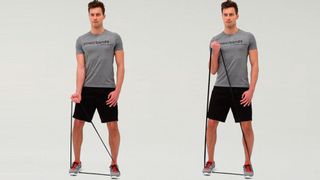
Sets 1 Reps 12-15 each side
Get the Coach Newsletter
Sign up for workout ideas, training advice, reviews of the latest gear and more.
Stand with feet shoulder-width apart with both feet on the resistance band. Grasp the band with one hand and hold it with your arm down at your side, palm facing forwards. Bend at the elbow and lift your arm toward your shoulders until you get a good biceps contraction. Then lower slowly back to the start. Do all your reps on one arm, then switch.
2 Flye
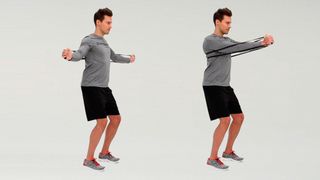
Sets 1 Reps 12-15
Hold the resistance band in both hands, arms stretched straight out to the sides at chest height, with the band going behind your back. Press the band straight out in front of you, bringing your hands together with your arms fully extended, keeping your elbows up throughout and squeezing your chest muscles as you press. Slowly return to the starting position.
3 Front squat

Sets 1 Reps 8-15
Stand on the resistance band with your feet slightly wider than shoulder-width apart, and bring the top of the band up to rest on the front of your shoulders. Lower into a squat, with your chest up and your knees over your toes. Then push up to the starting position.
4 Side-lying hip abduction

Sets 1 Reps 10-12 each side
Lie on your side with your hips and knees bent at 90° and the resistance band looped just above your knees. Raise the upper leg to pull your knees apart while contracting your glutes for two to three seconds, then slowly return to the starting position. Do all your reps on one side, then switch.
5 Glute bridge

Sets 1 Reps 10-15
Loop the resistance band just above your knees and lie on your back with your feet on the floor and your knees bent at 90°. Lift your toes off the floor, then raise your hips until you form a straight line from your knees to your shoulders, contracting your glutes throughout the entire movement. As you raise your hips open your knees slightly to press against the resistance band.
6 Band pull-apart
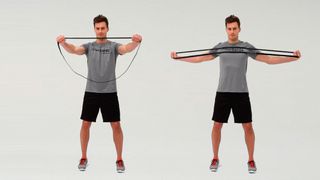
Sets 1 Reps 8-10
Stand with your knees slightly bent and your feet shoulder-width apart. Grip a shoulder-width section of the resistance band with both hands in front of you at shoulder height. Keeping your arms straight, pull the band out and back until your shoulder blades contract. Slowly return to starting position.
7 Lateral walk

Sets 1 Reps 8-10 steps in each direction
Loop one resistance band just above your knees and another around your ankles. Drop into a half squat position with your feet shoulder-width apart to create tension in the bands. Then take a small step to the side, keeping tension in the bands as you move. Do all the steps in one direction, then switch.
8 Press-up
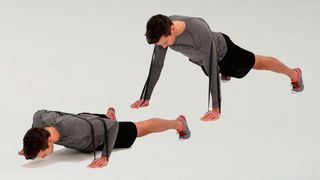
Sets 1 Reps 5-15
Get in a plank position, draping the resistance band across your upper back and holding the ends under your hands. Drop your chest down towards the floor, then contract your glutes and abs and push straight up until your arms are fully extended.
9 Squat to overhead press
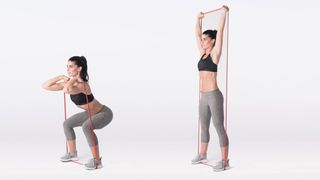
Sets 1 Reps 8-10
Stand on the resistance band with your feet shoulder-width apart. Position your hands at shoulder level with your palms facing up, holding the resistance band. Drop into a squat, then push back up and fully extend your arms so you raise the resistance band overheard. Then lower slowly into another squat.
To find out more about resistance band training or to buy powerbands, visit letsbands.com
FAQs
Can you really build muscle with resistance bands?
“Yes, absolutely!” says Mitch Raynsford, strength and conditioning coach at P3RFORM. “Resistance bands are highly effective tools for building muscle. To stimulate hypertrophy, an external load to work against is required and resistance bands allow this easily. They provide constant tension throughout the entire range of motion, challenging your muscles in a way that can lead to muscle growth over time. The resistance offered by the bands engages your muscles during both the concentric [lifting] and eccentric [lowering] phases of the exercises, promoting muscle activation and development.
“However, it’s important to progressively increase the resistance over time as your muscles adapt. This can be achieved by using bands with higher resistance levels or by incorporating more challenging exercises into your routine as you get stronger.”
Are resistance bands better than free weights?
“Both resistance bands and free weights can be effective tools for strength training and muscle building. For those looking for convenience and portability, resistance bands can be an excellent choice,” says Raynsford. “They also provide variable resistance, meaning the tension increases as the band is stretched, which often aligns with providing greater resistance as the movement gets easier across the strength curve. This can engage muscles more effectively through the entire range of motion. In contrast, free weights offer constant resistance—the load remains consistent throughout the movement.
“However, progression is often easier to follow with free weights due to the straightforward approach of choosing a heavier dumbbell. You can achieve this with resistance bands by choosing thicker bands or wrapping the band round twice but quantifying this can be tough.”

Mitch Raynsford is a certified personal trainer, UKSCA-accredited S&C coach, and the lead strength and conditioning coach at digital fitness coaching platform P3RFORM. He holds a MSc degree in Sports Science and Applied Sports Physiology from the University of Brighton. Mitch has worked for Aston Villa Women football club as the lead trainer preparing players for a return to competitive matches, and also took on the role of sports scientist with the senior squad.
More Resistance Band Workouts
Resistance Band Glute Workout
Resistance bands are a great tool for glute workouts. Loop one around your thighs and tackle the four moves in this session and your glutes will be on fire in next to no time no time. Do each move in the circuit for 30 seconds for two minutes’ work in total, then rest. Repeat for as many rounds as you like. You can do this as a standalone workout or add it on the end of a longer legs workout as a glutes finisher.
See the resistance band glute workout
Upper-Body Resistance Band Workout
Used in the right way, resistance bands are great tools for building upper-body muscle, and this 21s workout is the right way. With each move broken down into 21-rep bursts where you do seven of the bottom half of the movement, seven for the top half and then seven full reps, expect muscles you didn’t even know existed to ache the next day.
See the upper-body resistance band workout
Posture Workout To Relieve Shoulder Stress
This three-move workout is perfect for those who spend long days hunched over a desk, since it will relieve the tension in your shoulders and help improve your posture. You just need a long looped resistance band and five minutes – keep a band near your desk and break up the day with the exercises.
See the resistance band shoulder workout
30-Minute Resistance Band HIIT Workout
This home HIIT workout involves powering through a circuit of nine exercises, working for 40 seconds and then resting for 20 seconds, completing three rounds in total. You need a large looped resistance band for it, with a medium/light band (6kg-15kg) the best option for most people.
See the resistance band HIIT workout

Nick Harris-Fry is a journalist who has been covering health and fitness since 2015. Nick is an avid runner, covering 70-110km a week, which gives him ample opportunity to test a wide range of running shoes and running gear. He is also the chief tester for fitness trackers and running watches, treadmills and exercise bikes, and workout headphones.
